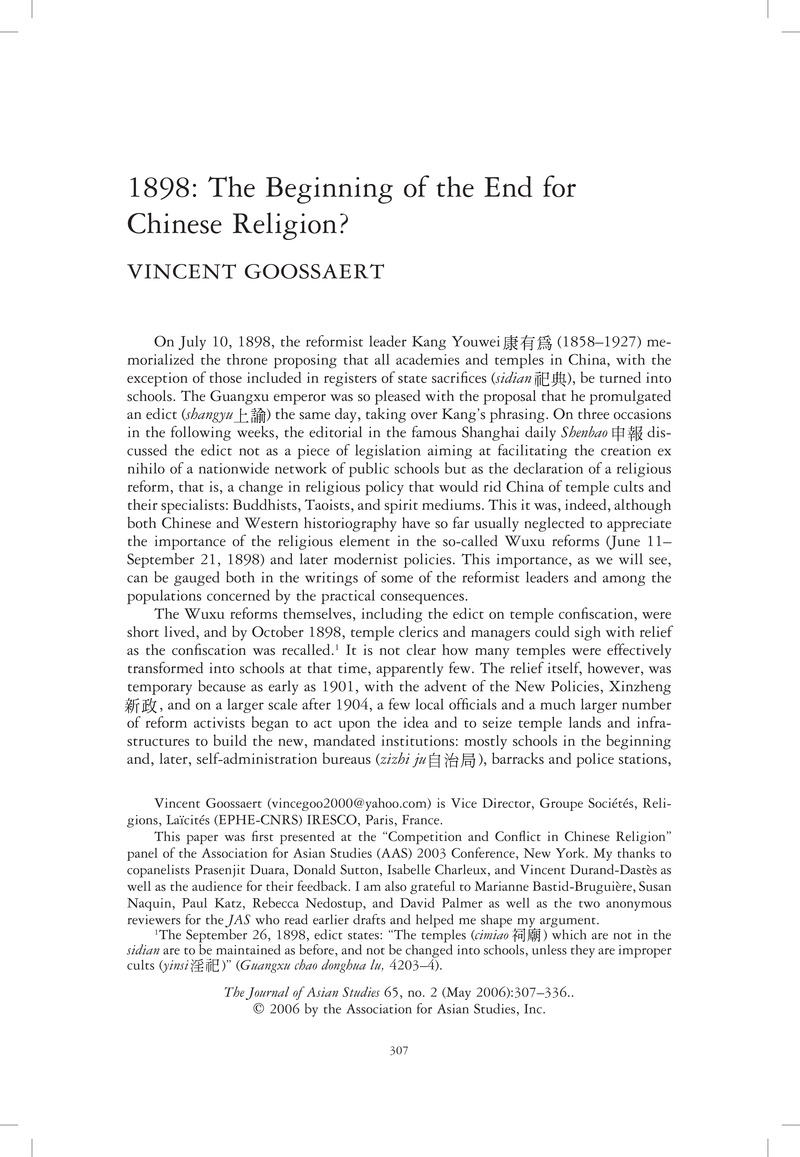Crossref Citations
This article has been cited by the following publications. This list is generated based on data provided by Crossref.
2008.
Revolution and the People in Russia and China.
p.
69.
Goossaert, Vincent
and
Ling, Fang
2008.
Les réformes funéraires et la politique religieuse de l’État chinois, 1900-20081.
Archives de sciences sociales des religions,
p.
51.
Nathan, Mark A.
2009.
The Encounter of Buddhism and Law in Early Twentieth-Century Korea.
Journal of Law and Religion,
Vol. 25,
Issue. 1,
p.
1.
Szonyi, Michael
2009.
Secularization Theories and the Study of Chinese Religions.
Social Compass,
Vol. 56,
Issue. 3,
p.
312.
Murray, Julia K.
2009.
“Idols” in the Temple: Icons and the Cult of Confucius.
The Journal of Asian Studies,
Vol. 68,
Issue. 02,
p.
371.
Laliberté, André
2009.
The Regulation of Religious Affairs in Taiwan: From State Control to Laisser-faire?.
Journal of Current Chinese Affairs,
Vol. 38,
Issue. 2,
p.
53.
Van Der Veer, Peter
2009.
The comparative sociology of India and China.
Social Anthropology,
Vol. 17,
Issue. 1,
p.
90.
Kuo, Ya-pei
2009.
“The Emperor and the People in One Body”.
Modern China,
Vol. 35,
Issue. 2,
p.
123.
Fisher, Gareth
2011.
In the Footsteps of the Tourists: Buddhist Revival at Museum/Temple Sites in Beijing.
Social Compass,
Vol. 58,
Issue. 4,
p.
511.
Klein, Thoralf
2011.
Conversion to Protestant Christianity in China and the ‘supply-side model’: explaining changes in the Chinese religious field.
Religion,
Vol. 41,
Issue. 4,
p.
595.
Abramson, Daniel Benjamin
2011.
Places for the Gods: Urban Planning as Orthopraxy and Heteropraxy in China.
Environment and Planning D: Society and Space,
Vol. 29,
Issue. 1,
p.
67.
Goossaert, Vincent
2011.
Détruire les temples pour construire les écoles : reconstitution d’un objet historique.
Extrême-Orient Extrême-Occident,
p.
35.
Liu, Xun
2011.
Proliferating Learning: Quanzhen Daoist Activism and Modern Education Reforms in Nanyang (1880s-1940s)1.
Extrême-Orient Extrême-Occident,
p.
53.
Ji, Zhe
2011.
Introduction : le jiao recomposé. L’éducation entre religion et politique dans la modernité chinoise.
Extrême-Orient Extrême-Occident,
p.
5.
Tarocco, Francesca
2011.
On the market: consumption and material culture in modern Chinese Buddhism.
Religion,
Vol. 41,
Issue. 4,
p.
627.
Yang, Mayfair Mei-hui
2011.
Postcoloniality and Religiosity in Modern China.
Theory, Culture & Society,
Vol. 28,
Issue. 2,
p.
3.
Klein, Thoralf
and
Meyer, Christian
2011.
Beyond the market: exploring the religious field in modern China.
Religion,
Vol. 41,
Issue. 4,
p.
529.
Laliberté, André
2012.
Buddhist Charities and China's Social Policy.
Archives de sciences sociales des religions,
p.
95.
Pacey, Scott
2012.
Flows of Faith.
p.
123.
Laliberté, André
2013.
The growth of a Taiwanese Buddhist association in China: Soft power and institutional learning.
China Information,
Vol. 27,
Issue. 1,
p.
81.



 .
. 